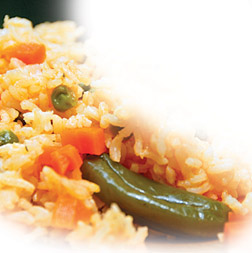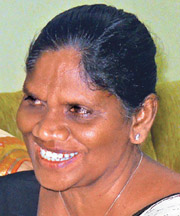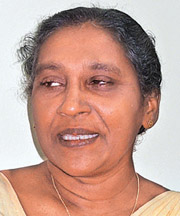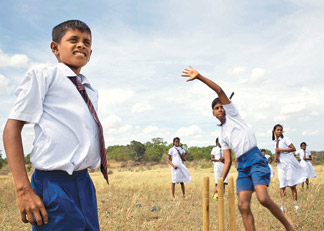Rice, more nutritious than wheat
By Dhaneshi YATAWARA
|

Plate of rice
|
Among the container-loads of food that Sri Lanka imports we have
spent Rs. 195 million to import wheat flour in 2009. Though it seems to
be far less than the Rs. 321 million we spent in 2006, the expense is
still a burden. Wheat is imported to provide food for the people whose
staple food had been rice over centuries. It may fill a hungry stomach
but, does it fulfill the nutritional requirements of the human body?
Sri Lanka has been a rice-consuming country since ancient times and
every meal with traditional food was a balanced diet rich in fibre.
Bread became a replacement to rice yet the habit of having a variety of
other curries with lots of vegetables and greens did not suit this
concept. Instead of having a balanced meal Sri Lankans started to load
themselves with bread - high in starch and minimal in fibre. According
to medical and education experts this habit worst affected children,
making the younger generation ill and inefficient.
"The main cause for the spreading of non communicable diseases such
as diabetes, heart diseases, gastro intestinal problems is eating a low
fibre diet. This is mostly observed in the western countries and to
prevent such a catastrophe eating more rice could provide a better
solution," said Dr. Shanthi Gunawardane, Consultant Community Physician
and Director of the Nutritional Coordination Division of the Ministry of
Health.

Renuka Peiris, Director of the School Health and Nutrition
Division |

Dr. Shanthi Gunawardane, Consultant Community Physician |
According to scientific findings the vitamins in the bran of the rice
gets absorbed inside while steaming, which is the first step of the
process in making paddy in to rice. Thus these nutrients has a high
chance in surviving in the cooking process. "If the food we consume
carry enough fibre it will control the amount of sugar and lipids
released in to the blood during the human digestion process," said Dr.
Gunawardane. It also contains a high amount of amino acids especially
the most essential ones like Lysine, Threonine, Cystine, Methionine,
Tryptophan.
"As rice contains more fibre than bread it becomes a filling meal and
we can be active for a longer time without being hungry," she said. As
Dr. Gunawardane explained further, though a 100 grams of rice can give
us a small amount of fibre, as we eat it for all three meals the daily
fibre content becomes high. "Fibre content in the food is the key to
healthy life," she added. But in wheat flour the fibre content lowers
from 2.24% to 0.34% as the bran is removed from 93% to 70%.
Speaking about the Sri Lankan school population Director of the
School Health and Nutrition Division of the Ministry of Education Renuka
Peiris, said that the food habits of the school children are making them
less fit. "We need to create a healthy, active younger generation. And
according to many researches done in Sri Lanka shows that children lack
healthiness - they are either obese or malnourished," Peiris added.
According to her with the inception of a free meal in selected schools
where rice and rice flour based food are provided children concentrated
more on education and showed more enthusiasm in the school activities.
"On these observation the Education Ministry took steps to promote our
staple food among the school community," Peiris said explaining the new
trends taking place in schools. "We believe the best way is to make the
child aware of the benefit of having a healthy life which would lead to
a change in his or her behavioural pattern," she added.
In this way the child is educated to understand his or her health
level by themselves and take steps to restore their healthiness. " This
is a long term process but we believe it will be more successful rather
than dictating to the child on what to eat and do," she said.
Through the Ministry of Education a special program is conducted to
check the health factors among children in selected schools. "By
creating a health friendly atmosphere in the school the message
eventually goes to the family and it would be the best method to educate
the entire community," said Peiris.
|

An active future generation |
Under these new steps the education authorities were able to bring
the consumption of wheat flour based products to a control. "We may not
be able to succeed 100% quickly yet we see a progress - especially in
rural and estate sector schools," she added.
The free meal concept promoting rice consumption covers 80% of the
schools in the country. Yet considering the entire school population it
covers only 25% and the authorities plan to increase this with more
health awareness programs in schools.
With a massive paddy production expected in the coming harvest season
the Economic Development Ministry plans to promote rice flour among
bakery owners that would cut down a significant quantity of wheat flour
imported and eventually cut down money flowing unnecessarily out of the
country.
As authorities of this new program will be carried out across the
country starting from the Colombo district. The technical know how will
be the most important factor in this transformation.
Bringing back a healthy concept to the community and stabilizing it
does take its own time.
Yet with a bit of an extra effort it is high time for the Sri Lankans
to value our own traditions and food habits in order to make a healthy
nation and a strong future generation. |

